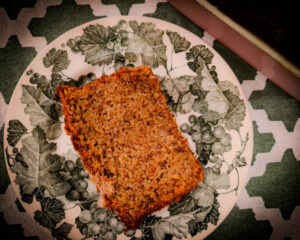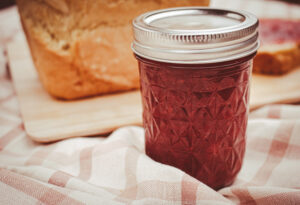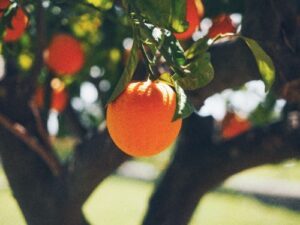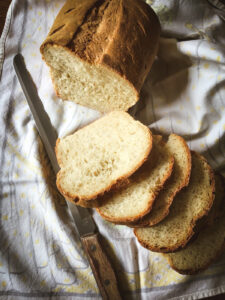Seven Suggestions
for Making the Most of
Apple Season
(Even If You Aren’t Feeling Very Crunchy)

Dr. Dixie Dillon Lane
Question: What is there that is even crunchier than all the weedlessly-homesteading, perfect-child-rearing, organic-handspun-alpaca-wool-wearing influencers on social media?
Answer: A freshly-picked apple.
You know, sometimes when mere mortals such as yours truly read on the internet about homesteading, homeschooling, domestic economies, and spinning straw into gold, we can feel a little discouraged and overwhelmed. Does powdery mildew just not come for influencers’ gardens? Do frozen corn dogs truly never pass influencers’ children’s lips?
Is the only way to lead a good life really to be so darn picturesque?
Well, of course not. And we should push back against this fear of not being good enough, because doing everything according some elusive standard is really not the point of seeking to ground ourselves in the ways of “hearth” and “field,” is it? The point is to draw closer to all that is good, to prune ourselves along with our gardens (if we have a garden), and to live in steady connection with ourselves, our families, our God, and our neighbors. It is not to teeter between perfection and utter failure, but rather, to grow.
You don’t have to have forty acres and wear only linen and wool in order to benefit from the goodness of our natural world. Please don’t be put off by a sense of immoveable standards out there on the internet (or elsewhere). The good life is for apartment-dwellers, public-school-goers, and unmarried female CEO’s just as much as it is for the very “crunchiest” influencers. Whether you have acreage or only yardage, whether you belong to a large family or a small one, and whether or not you support your family by digging in the dirt, you can still do things to connect yourself to the land and your cultural roots in good food and conviviality.
So, having put Instagram-style standards aside, let us think of some little ways that we can take on a homestead-y project whether or not we have the lifestyle, wealth, and paid workforce of a celebrity horticulturist. We’ll begin where we started, with that crunchiest of all creations, the autumn apple and, more specifically, the wonderful fall fixture known in our house as “Apple Week.” Which, just to be clear, is something I just made up, not another one of those Named Weeks handed down to the calendar-makers from somewhere on high.
Apple Week is nothing more and nothing less than a week that you — because you are the boss, you know — choose to set aside sometime in autumn to celebrate the goodness of the apple harvest. It is not overwhelming, however. It is a time to take a breath and do just two or three little things to tell yourself and your family through taste, smell, sight, touch, and togetherness that the goodness of the harvest is here and that you, as a human being, are a part of this goodness.
If all that sounds rather highfalutin, let me bring it down to reality through seven simple suggestions for celebrating Apple Week this year in your own realistic context.
1. Make Time For Apple Week By Choosing Between Goods.
Apple Week is, indeed, a whole week, or at least a week of weekdays. Or thereabouts. I will not come running after you to bash you over the head with a calendar if you don’t make it an entire week! But you will need to make a little time to devote to enjoying apple season by clearing a few afternoons in a row, whether after school (if your work schedule allows) or during the day in place of homeschooling (Apple Week is very educational!) A weekend works, too, if you can’t make time on weekdays.
 In order to clear time to celebrate Apple Week, you will have to turn down other goods, such as certain regular chores or some social engagements. That’s okay! If you plan Apple Week in advance, you can integrate it into your work and your social life; just invite your friends along for one part or another of the process. You can’t do everything, nor should you try. Choosing between goods is just another good thing to manage in a thriving life.
In order to clear time to celebrate Apple Week, you will have to turn down other goods, such as certain regular chores or some social engagements. That’s okay! If you plan Apple Week in advance, you can integrate it into your work and your social life; just invite your friends along for one part or another of the process. You can’t do everything, nor should you try. Choosing between goods is just another good thing to manage in a thriving life.
2. Begin With Stories.
If your children are elementary-aged or younger, hie yourselves over to the library and check out some picture books on Johnny Appleseed. John Chapman was a real historical figure who has passed into myth; it’s fun to read about the real Chapman (a fascinating religious figure) as well as about the Johnny Appleseed tall tales based on him, depending on your interests and your children’s ages. Spend the first day or two of Apple Week immersed in stories.
If you do not have children or they are grown, consider borrowing somebody else’s kids. Children transform Apple Week from work into fun, and you’ll also give some tired parents a much-needed break if you offer to take their kids for a few hours.
3. Find An Orchard and Get Picking.
Gather up the kids — your own or borrowed — and spend an afternoon at a local orchard picking as many different varieties of apples as you can get.  This is a good opportunity for older children to experience some independence as they go off picking unsupervised in groups; if you’re worried about them getting lost or someone bothering them, issue them a dumbphone and a menacing threat about how they will have to be personally in charge of peeling all the apples if they fail to return at the appointed time. Even your young teens are unlikely to complain if they get to pick independently.
This is a good opportunity for older children to experience some independence as they go off picking unsupervised in groups; if you’re worried about them getting lost or someone bothering them, issue them a dumbphone and a menacing threat about how they will have to be personally in charge of peeling all the apples if they fail to return at the appointed time. Even your young teens are unlikely to complain if they get to pick independently.
Some orchards also have playgrounds, corn mazes, pumpkin patches, and even trains shaped like cows around to make the experience fun for the whole family. You can also add to your apple stash by buying seconds (bruised apples) at a discount; you can cut the bruised parts off later.
Do not be foolish enough to attempt to leave without buying everyone apple cider donuts, however, or you will have a mutiny on your hands when it comes time to peel and slice the apples. Write it off as a cost of doing business.
4. Serve Pie for Dinner.
When you return from the orchard, you will be tired, and you will acknowledge that even though you wrote on the kids’ Montessori school application that they watch “fewer than two hours” of TV per week, you are feeling very tempted to bend your screen time rules today just so that you can recover a little.
So I suggest putting on a relatively quiet and calm movie for the kids (or sending them back home to their parents! Or, if you’re their parent, even just to their rooms to rest) and committing yourself to just a little more work in the form of the quiet, meditative task of making an apple pie for dinner (fry up some eggs and slice some cheese to go along with the pie when dinnertime comes).
But what if you are terrified of making pie crust, or don’t have the energy after wrangling forty-two (or wait, was it really just two?) toddlers as they darted through the apple trees? Don’t let the perfect be the enemy of the good. Use Pillsbury if you need to (or make the crust in advance and have it waiting in the fridge). Remember, the influencers will never know.
Then mix together 7-9 peeled, sliced apples, ¾ or 1 cup sugar, ¼ cup flour, a teaspoon of cinnamon and a pinch of salt (and a drizzle of lemon juice, if you like) and toss all this into the bottom crust. Top it with the top crust, cut a vent for the steam, and pop it into the oven at 375 degrees, leaving it there until the pie’s juices have been bubbling for at least 20 minutes (about 90 minutes total). Let it cool before serving, if you have time, so that the juices can settle.
You can do fancier things with your pie, too, if you like: lattice, braided, or crumble tops, or applying egg wash and sanding sugar; you can even make turnovers or an easy cobbler or crisp if you want, instead.
But a good enough pie is still just that: good enough. It also pairs well with take-out pizza (which is also a pie, you know).
5. Outsource What You Can.
In a day or two or three, when people are tired of eating fresh apples and reading about Johnny Appleseed, start thinking about making applesauce and apple butter. But don’t do all the work yourself; oh, no. Outsource as much of it as possible.
 Once again, gather some kids, and this time get them a-peelin’. Make them an apple cobbler as a reward if you have to! Most kids of about eight years and older are able to peel well, if slowly, and they love to eat the peels as they go. Put yourself and another adult or older kid on slicing duty, and station the toddler and kindergartner beside you with their own pre-peeled, pre-sliced apples and a couple of bench scrapers; they will manage a surprising among of chopping without cutting themselves. Throw their mangled choppings in with the rest for your recipe; why not? Your sauce or butter will be just fine.
Once again, gather some kids, and this time get them a-peelin’. Make them an apple cobbler as a reward if you have to! Most kids of about eight years and older are able to peel well, if slowly, and they love to eat the peels as they go. Put yourself and another adult or older kid on slicing duty, and station the toddler and kindergartner beside you with their own pre-peeled, pre-sliced apples and a couple of bench scrapers; they will manage a surprising among of chopping without cutting themselves. Throw their mangled choppings in with the rest for your recipe; why not? Your sauce or butter will be just fine.
Hearth & Field has recipes for both applesauce and apple butter, and there is almost nothing easier to make — and yet the taste is superb! You will want to watch the butter or sauce carefully while it is on the stove (this is a job for an adult or older teen, as burns and scalding are real dangers), or you can further outsource the job to a slow-cooker, which works wonders with apple butter.
To make things even easier, in truth, you don’t even have to peel the apples for either apple butter or applesauce, depending on how you like them. But do make sure to soak or wash the apples well to remove any pesticides if you choose to forego the peeling.
6. Teach the Tree.
If you are folding Apple Week into homeschooling or are otherwise a curious person, you can have a lot of fun on one afternoon in Apple Week by looking through some kids’ books about trees and apples and how they grow. Cutting an apple in half to see the hidden star that the seeds make within it is magical for children, and the life cycle of the tree explains much about how our world works. Reviewing this is also a nice way to prepare yourself for the turning of the year and the changes about to come in winter, and to remind yourself that despite their barren appearance, the winter trees are not dead, but merely sleeping. Life goes on.
If you are artistic or crafty, there are also endless creative things to do with apples. You can dry thinly sliced apples on low heat in the oven and then string them together with cranberries and popcorn to make an autum decoration (dried orange slices work well, too!). You can dip halved apples in paint and make apple-stamp paintings or even T-shirts. You can get out the clay and make simple apple-shaped pinch pots, then paint and seal them to give to the grandparents as gifts. There are so many fun things to do with apples.
7. Preserve the Bounty.
If you’ve made a lot of applesauce, apple butter, spiced apples, or apple pie filling, you may want to preserve them through canning.
Like discussing making pie dough from scratch, talking canning tends to make people feel nervous or even inadequate. But you have options! Some things can be frozen with success instead of being canned; apple butter, pie filling, and entire pies all store well in the freezer for three or so months.
But if you’re willing to put in the courage just once to learn to can things well and safely, you’ll find that there’s actually not much to it. It does take attention — don’t try it with the baby in a carrier on your back — but it’s pretty easy and quite safe if you follow good guidelines. The USDA has a free PDF that will tell you exactly how to do it safely and easily no matter what you are canning, what method you wish to use, or what size jars your have. Or you can ask a more experienced friend!
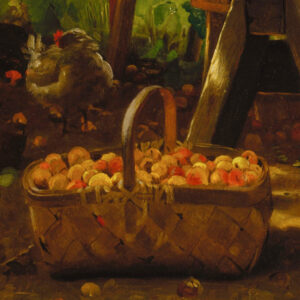 The main trick to enjoying Apple Week is to refuse to allow it to become a source of perfectionist panic or imposter syndrome. Just pick as many apples as you want. Make as many dishes with them as you want. Process and can them or don’t; it’s your choice.
The main trick to enjoying Apple Week is to refuse to allow it to become a source of perfectionist panic or imposter syndrome. Just pick as many apples as you want. Make as many dishes with them as you want. Process and can them or don’t; it’s your choice.
In other words, once again: don’t let the perfect be the enemy of the good. Try an easy and relaxed Apple Week and enjoy some time in the sunshine with the people you love and the timeless traditions of the harvest. Apples are for everyone. As the old “Johnny Appleseed” grace goes,
The Lord is good to me
And so I thank the Lord
For giving me the things I need
The sun and the rain and the apple seed
The Lord is good to me.
So why not enjoy it?





